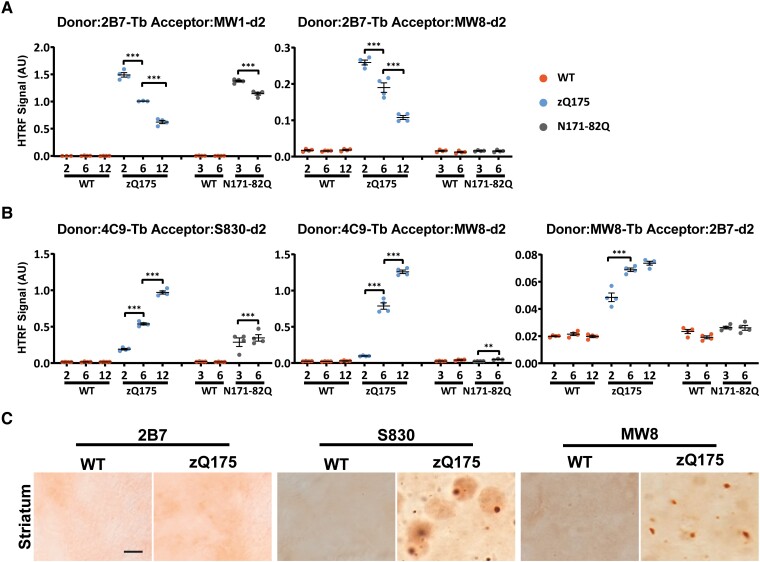Figure 3.
The 4C9-MW8 and MW8-2B7 HTT aggregation assays are specific for HTTexon1. (A) The 2B7-MW1 and 2B7-MW8 HTRF assays were applied to cortical lysates from heterozygous zQ175 mice and wild-type littermates at 2, 6 and 12 months of age and from N171-82Q mice and their wild-type littermates at 3 and 6 months of age. The 2B7-MW1 assay detects ‘soluble mutant HTT’ and a signal was detected in both the zQ175 and N171-82Q lysates. There was no signal in the wild-type mice as they do not produce mutant HTT. In contrast, the 2B7-MW8 assay only produced a signal in zQ175 lysates, but not those from N171-82Q mice, confirming its specificity for soluble HTTexon1. There was no signal in wild-type mice as they do not produce HTTexon1. N = 4/genotype/age. WT = wild type, AU = arbitrary units. (B) The three HTRF aggregation assays (4C9-S830, 4C9-MW8 and MW8-2B7) were applied to cortical lysates from zQ175 mice and wild-type littermates at 2, 6 and 12 months of age and from N171-82Q mice and their wild-type littermates at 3 and 6 months of age. The 4C9-S830 assay detected aggregated HTT in both zQ175 and N171-82Q mice, whereas, in contrast, the 4C9-MW8 and MW8-2B7 assays only detected aggregated HTT in zQ175 mice, indicating that these assays are specific for aggregated HTTexon1. N = 4/genotype/age. Error bars are mean ± SEM. The test statistic, degrees of freedom and P-values for the two-way ANOVA are provided in Supplementary Table 7. Statistical differences are indicated when there is a difference from 1 month to the next *P ≤ 0.05, **P ≤ 0.01, ***P ≤ 0.001. WT = wild type, AU = arbitrary units. (C) Striatal sections from 6-month-old zQ175 and wild-type mice immunostained with the 2B7, S830 and MW8 antibodies. S830 detected nuclear inclusions, a diffuse nuclear aggregation signal and smaller cytoplasmic inclusions. MW8 showed a similar nuclear and cytoplasmic staining pattern to S830 but did not show the diffuse aggregation in the nucleus. 2B7 did not detect HTT aggregates. N = 3/genotype. Scale bar = 5 µm. WT = wild type.

